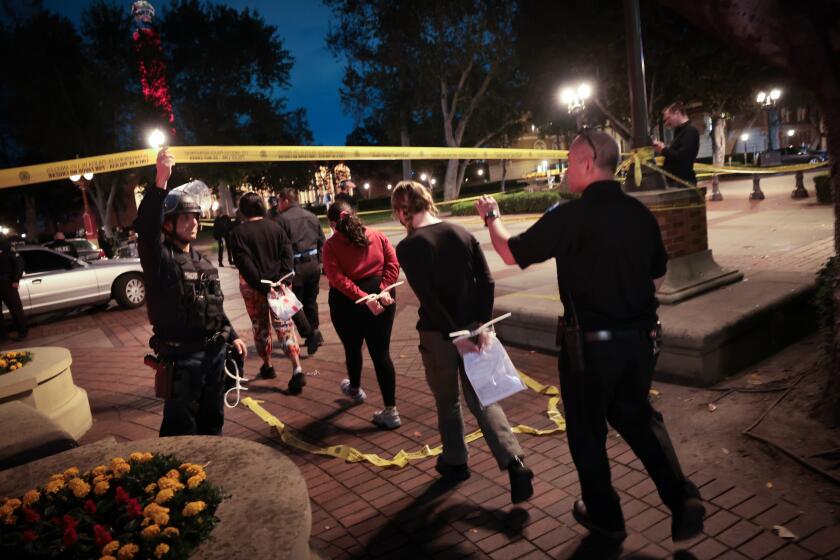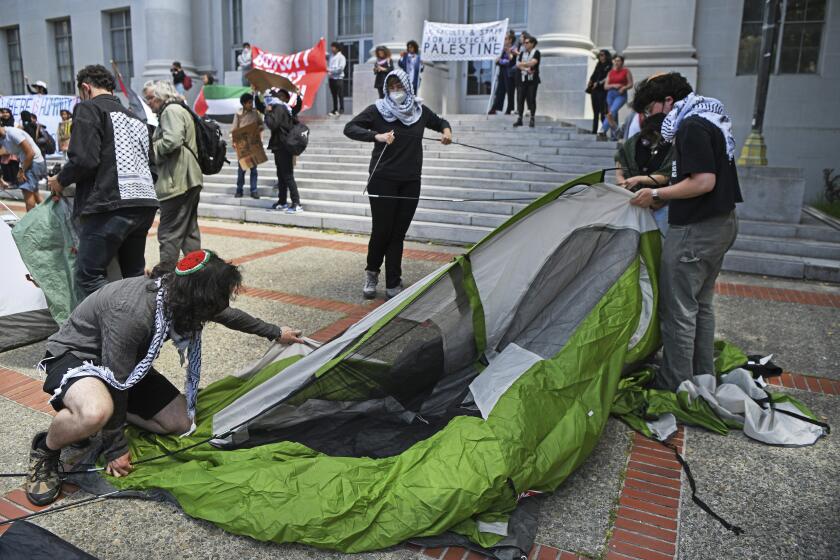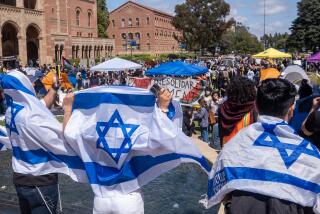Column: The crackdown on student protesters shows exactly why we need them

- Share via
Pro-Palestinian protests continue to spread on American campuses for one simple reason: They are working.
You do not have to agree with the protesters’ politics and demands — which in most cases involve universities divesting from firms that contribute to the Israeli war effort — or their methods, which include setting up tent encampments on shared spaces, to acknowledge that the demonstrations are doing exactly what student demonstrations almost always do.
That is, force this country to face issues that many would prefer to ignore or dismiss.
Including if, and how, students should be allowed to gather and make their feelings known.
Let’s settle that last issue right now: Of course students are allowed to protest. This country is quite literally built on protest, and we take pride in the many student demonstrations that have regularly contributed to changes in policy and cultural attitudes.
In 1960, student sit-ins at the segregated Woolworth lunch counters of Greensboro, N.C., became one of the most famous actions of the civil rights movement. In 1968, a months-long demonstration at San Francisco State led to the creation of African American (and, subsequently, other ethnic and gender) studies programs. That same year, Chicano students walked out of high schools in East Los Angeles in protest of unfair treatment, galvanizing the Chicano movement.
Students effectively protested the war in Vietnam, the forced silence of rape victims, South African apartheid, the policies that created the climate crisis, for (and sometimes against) abortion rights.
Virtually all of them were criticized and disparaged at the time.
And yet every time widespread and sustained campus demonstrations occur, the reaction is alarmingly predictable. Not to mention historically obtuse. First comes shock: Students are protesting? Then condemnation: Get these overprivileged kids back to class, and call the cops if you have to!
Hearing this from boomers, many of whom cleave tightly to memories of their own demonstrating days, has a particularly embarrassing “Get off my lawn” subtext. And aren’t these the same young people regularly accused of apathy, isolation and social media addiction? Look! They’re off their phones!
LAPD officers in riot gear arrested 93 people on trespassing charges as they cleared an encampment at the center of the USC campus that formed in protest against the Israel-Hamas war.
People go to college for all sorts of reasons, but one of them is surely to learn about the world and figure out their place in it, including their right to free speech and peaceful assembly. Those who run universities should have plans in place to deal with student protests, because student protests are inevitable. In fact, the first question any prospective student or parent should ask on those endless college tours is, “What is your plan for dealing with student protests?” — that will tell you more about your “fit” with the school than any list of college clubs.
And the answer should never involve almost-immediate mass suspension, eviction, arrest and violence, as we’ve seen on campuses across the country in recent days.
Whether from a small fringe of students or from nonstudents infiltrating the protests with their own agendas, there have been horrifying examples of antisemitic rhetoric amid the protests, including celebrations of Hamas’ goals (which include eradicating the state of Israel) and Jewish students being told to go back to Poland or warned that “every day will be Oct. 7.”
But at the growing number of universities involved, the demonstrations have largely been peaceful protests against Israeli government policies, U.S. military aid and neglect of Palestinian suffering. Many have included gestures of interfaith solidarity such as prayer circles and Passover seders.
The severity of the crackdown by university leaders and local police departments makes it hard to understand what they are hoping to achieve, beyond deepening historical divisions and creating new ones — not only between students and administrators but now between faculty and administrators — while bringing more attention to the very protests they are hoping to quell.
All campuses have rules, and breaking them should have consequences. (Is there no disciplinary measure short of “permanent exile” available here?) But as the president of Columbia is now learning, locking students out of their dorms, tossing their belongings into alleys, kicking them out of school and bringing in an armed and uniformed presence to forcibly disrupt generally peaceful demonstrations is guaranteed to make the situation worse.
As sprawling pro-Palestinian protests and encampments escalate on university campuses across the United States, administrators respond with more discipline.
Students protesting is one story; students being arrested, expelled and evicted from their housing for protesting is quite another.
Especially when the arrests and discipline appear broad and random rather than targeted at those individuals who may be engaged in antisemitic hate speech.
This doesn’t absolve the protesters of responsibility. If students want to have a real impact on what their universities or the U.S. government fund, they need to ensure that no one is using their demonstrations to spew hate. The best way to convince doubters that people can be pro-Palestinian and not antisemitic is to prove it.
But it has always been easier to criticize the invariably imperfect actions of young people rather than acknowledge and address the basic issues they are protesting.
Which in this case include the continued mass killing and displacement of Palestinian civilians.
Any large demonstration is going to include bad-faith actors and individuals who are ill-informed about the issues. But the thorniness of this particular conflict — a standoff between two historically threatened and marginalized groups that has shaped international relations for more than a century — and the intense reaction to these protests prove exactly why they are so necessary.
More acutely than any moment since Oct. 7, the rest of us have been forced to reckon with the conflict, and all the personal horrors and cultural antipathy it has symbolized and engendered, because suddenly it is in our backyards.
After all, the division over the war in Gaza is by no means confined to students. As has happened with so many rifts in our country’s history, students have simply used their activism to become a prism reflecting the wider world. Which is why they need to be taken seriously, for all of our sakes.
If they do nothing else, the growing demonstrations are forcing us to confront who we are, what we believe and why.
What is happening in Gaza is not a war “over there.” It’s right here, right now, among our own children. And we all need to figure out where we stand.
More to Read
The biggest entertainment stories
Get our big stories about Hollywood, film, television, music, arts, culture and more right in your inbox as soon as they publish.
You may occasionally receive promotional content from the Los Angeles Times.













